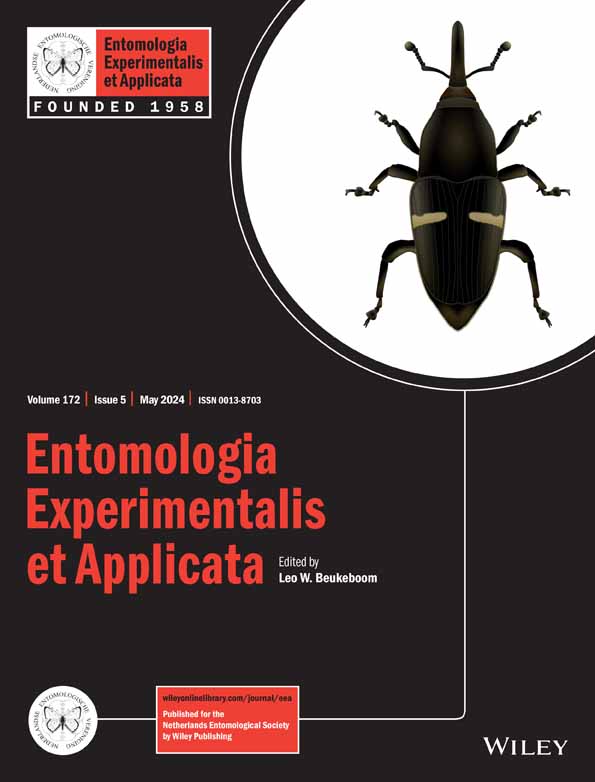Ver ítem
- xmlui.general.dspace_homeCentros Regionales y EEAsCentro Regional Tucumán - Santiago del EsteroEEA FamailláArtículos científicosxmlui.ArtifactBrowser.ItemViewer.trail
- Inicio
- Centros Regionales y EEAs
- Centro Regional Tucumán - Santiago del Estero
- EEA Famaillá
- Artículos científicos
- Ver ítem
Consumption and preference rates of the various larval stages of Allograpta exotica as biological control agents of Myzus persicae and Frankliniella gemina
Resumen
Fruit and vegetable crops are affected by numerous arthropods, including aphids and thrips. Hoverfly adults are important pollinators, and their larvae are mainly aphid predators. Molecular studies on the stomach contents of larvae allowed to associate hoverflies with the consumption of other soft-bodied arthropods, including thrips, with few records found in Neotropical hoverfly species. Allograpta exotica (Wiedemann) (Diptera: Syrphidae), a species
[ver mas...]
Fruit and vegetable crops are affected by numerous arthropods, including aphids and thrips. Hoverfly adults are important pollinators, and their larvae are mainly aphid predators. Molecular studies on the stomach contents of larvae allowed to associate hoverflies with the consumption of other soft-bodied arthropods, including thrips, with few records found in Neotropical hoverfly species. Allograpta exotica (Wiedemann) (Diptera: Syrphidae), a species widely distributed in the Americas, from the USA to Argentinian Patagonia, has been associated with numerous crops mainly affected by aphids, and to a lesser extent with whiteflies. The objective of this work was to assess the consumption and preference rates of various instars of A. exotica as biocontrol agents for two major insect pests, Myzus persicae (Sulzer) (Hemiptera: Aphididae) and Frankliniella gemina (Bagnall) (Thysanoptera: Thripidae), under controlled laboratory conditions. Additionally, we morphologically characterized the three larval stages of A. exotica. We determined that all three instars of A. exotica consume both M. persicae and F. gemina, and that they kill more thrips than aphids. Still, A. exotica preferred M. persicae over F. gemina, even when the relative aphid availability decreased compared to F. gemina, although consumption of both prey types remained high. Interestingly, A. exotica second instars consumed four times more thrips than aphids. This study explored the potential use of one of the most common hoverfly species in fruit and vegetable crops as a biocontrol agent of aphids and thrips. Further laboratory and field studies should explore more deeply the potential of this Neotropical beneficial dipteran.
[Cerrar]

Autor
Maza, Noelia;
Páez Jerez, Paula Gabriela;
Bressán, Emilse;
Funes, Claudia Fernanda;
Kirschbaum, Daniel Santiago;
Fuente
Entomologia Experimentalis et Applicata : 1-10. (First published: 29 March 2024)
Fecha
2024-03
Editorial
Wiley
ISSN
0013-8703
1570-7458
1570-7458
Documentos Relacionados
Formato
pdf
Tipo de documento
artículo
Proyectos
(ver más)
INTA/PNHFA-1106073/AR./Aumento de la competitividad con sustentabilidad y equidad social de sistemas productivos de hortalizas frescas diferenciadas.
INTA/2019-PE-E1-I500-001, Intensificación sostenible de sistemas hortícolas
Palabras Claves
Derechos de acceso
Restringido
 Excepto donde se diga explicitamente, este item se publica bajo la siguiente descripción: Creative Commons Attribution-NonCommercial-ShareAlike 2.5 Unported (CC BY-NC-SA 2.5)
Excepto donde se diga explicitamente, este item se publica bajo la siguiente descripción: Creative Commons Attribution-NonCommercial-ShareAlike 2.5 Unported (CC BY-NC-SA 2.5)
Metadatos
Mostrar el registro completo del ítem
Excepto si se señala otra cosa, la licencia del ítem se describe como info:eu-repo/semantics/restrictedAccess
Ítems relacionados
Mostrando ítems relacionados por Título, autor o materia.
-
Manejo de malezas en el cultivo de pecán
Taiariol, Dario (EEA Bella Vista, INTA, 2022-12-15)Una planta no deseada en un lugar no deseado. No siempre invasivas o salvajes. Efectos adversos de malezas. -En plantas jóvenes: Compite y afecta la disponibilidad de nutrientes, luz y agua y, además, alelopatías. - En ... -
Taladrillo de los forestales: algunos aspectos de su biología, detección y manejo de poblaciones
Cichon, Liliana; Garrido, Silvina Alejandra; Lago, Jonatan; Ahmad, Samir (EEA Alto Valle, INTA, 2013)Megaplatypus sulcatus Chapius, conocido vulgarmente como "barreno" o "taladrillo de los forestales", es un coleóptero que produce severos daños en plantaciones forestales y frutales perforando el tronco de los árboles, ... -
Revalorización del Complejo de Depredadores Polífagos Asociado al Cultivo de los Cítricos, Como Agentes de Control Biológico de Plagas Claves
Bouvet, Juan Pedro (Departamento de Producción Vegetal, Universitat Politècnica de València, 2018-12)Dentro de los enemigos naturales de plagas en los agroecosistemas, los depredadores han sido considerados como uno de los grupos de mayor importancia. Sin embargo, su compleja biología y comportamiento ha obstaculizado en ...


